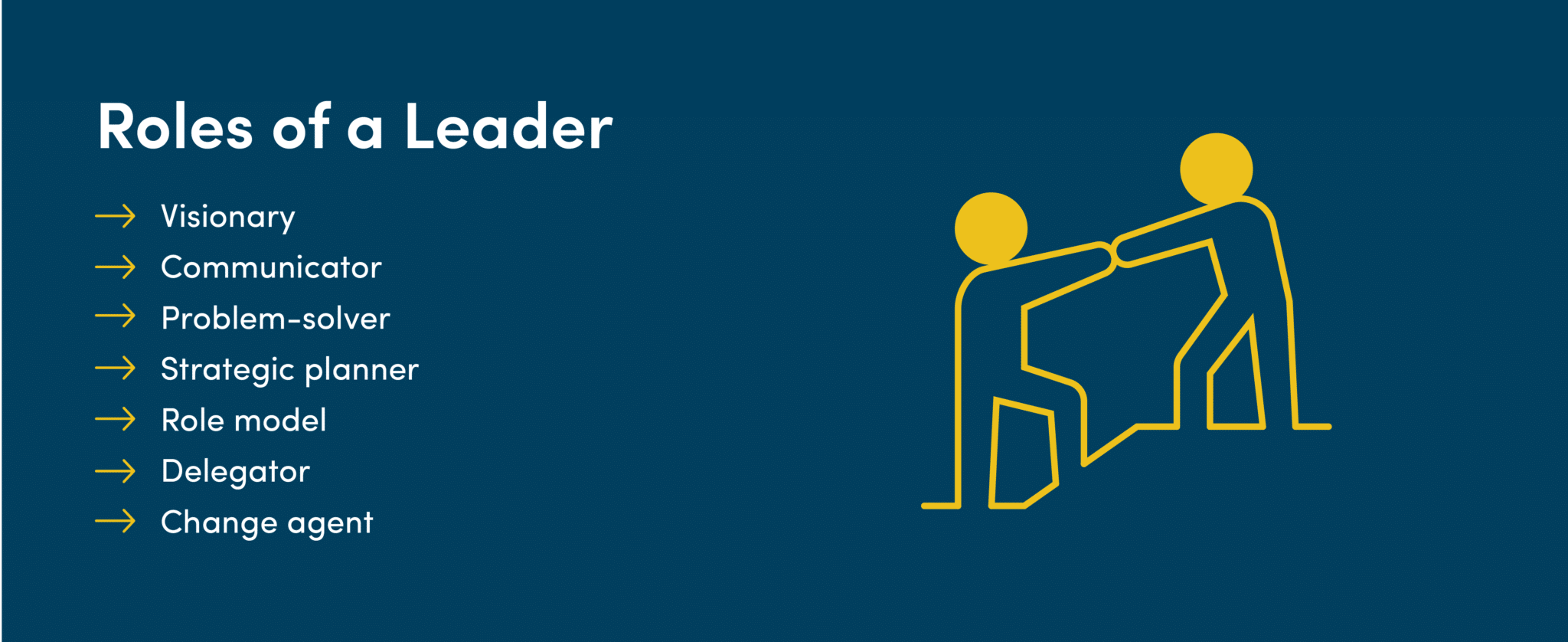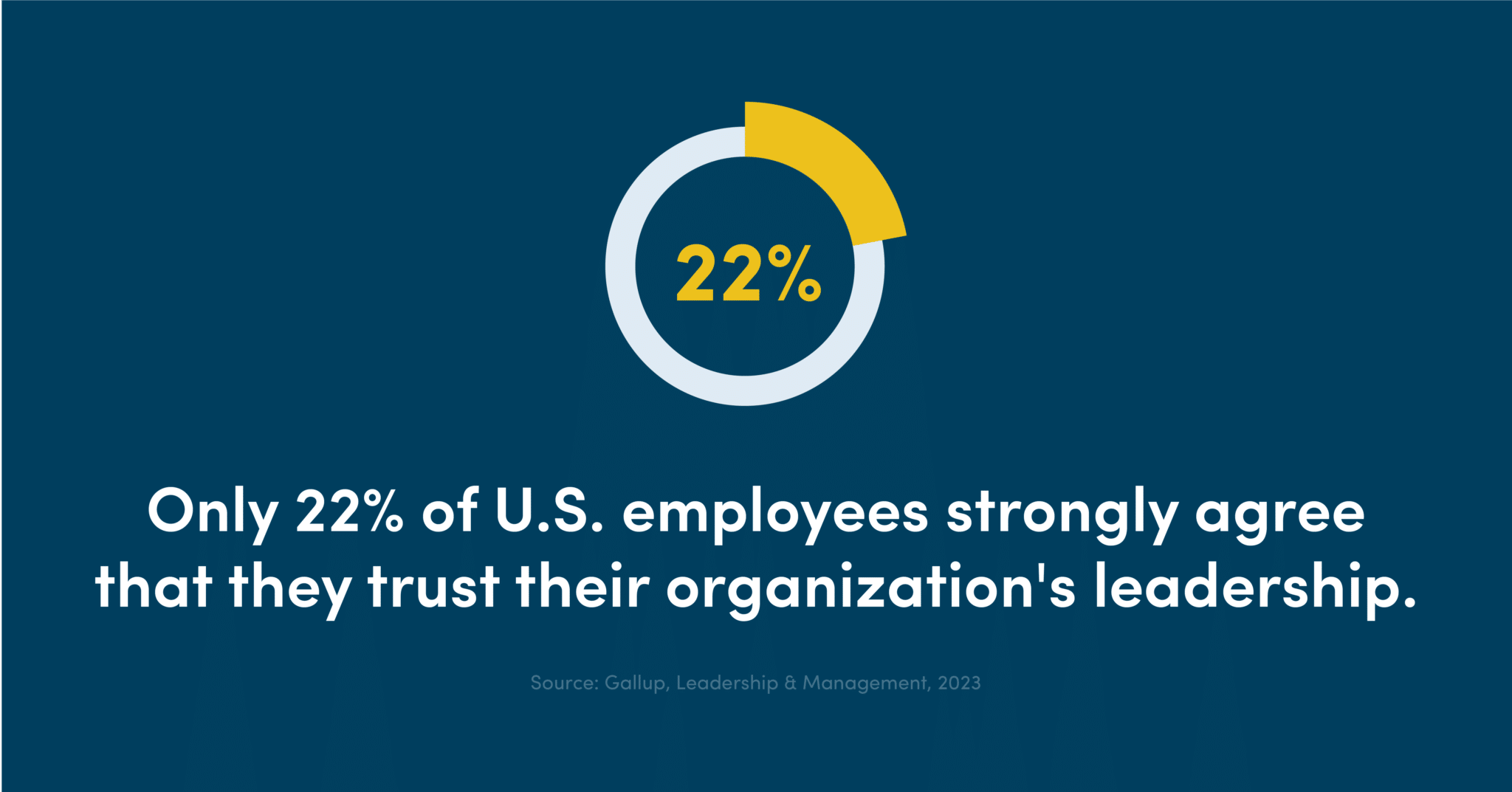What Is the Role of a Leader?

So, what is the role of the leader?
Google this question and you’ll find countless definitions, articles, courses, videos, self-help books and more. In short, however, the role of a leader is to act as a visionary who can organize and manage a team to achieve goals and a desired outcome.
Hosted by Glen Daley, Vistage Speaker and leadership expert, our recent webinar took a deep dive into what the leader’s key responsibilities are, what they owe to their team and how they can build trust through their actions.
Throughout this article, we’ll break down some of the webinar’s highlights. But for the full session, you can view the recording here.
- What Is a Leader?
- What Are the Roles of a Leader?
- How Can You Become an Effective Leader?
- Why Are Effective Leaders Important?
- How Can Leaders Lead By Example?
- How Can Leaders Build Trust?
- Wrapping Up: Roles of a Leader
What Is a Leader?
A leader is someone who has the vision to take an organization and make it into something that’s dynamic, exciting, progressive, and functional. They inspire their followers to become successful in their own right, giving everyone the tools they need to do their jobs right, and supporting everyone at all levels of the organization. The leader also has the ability to make tough decisions, hold people accountable for their actions, and take responsibility for failures as well as successes.
Leadership involves stepping into the top role of an organization and taking on various responsibilities. These responsibilities are varied and often seem like they’re independent of each other in terms of what needs to be done on a daily basis. It’s the job of leadership to take all of these responsibilities, keep them flowing, and bring them together in a balanced and harmonious fashion for the good of the organization.
The leader has to be able to pay attention to the workings of the organization in order to be effective. They also possess qualities that make them respected by their employees and management, making the organization a place people want to work.
What Are the Roles of a Leader?
A leader is someone who has to show proficiency in different roles throughout their working day. They can find themselves participating in the final draft of creating an employee handbook, looking over the financials for a given period, and making decisions that are intended to improve the operations of the company. This requires the ability to act as a force of nature to make moves that result in success, yet be humble enough to admit it when something’s going wrong. The following is a look at the different leadership roles that go into making someone a leader.

1. Visionary
Being a visionary is arguably the most important role of a leader. A leader without a vision is one that doesn’t inspire others to support them in their efforts to bring a business to its full potential. In contrast, a leader who thinks big and seeks to engage everyone in pursuit of that vision is someone who’s most likely to achieve their goals for the organization.
Another aspect of being a visionary is that it attracts quality employees who want to be a part of an organization that’s led by someone who fosters innovation, creates new products and services, or improves people’s quality of life. With a clear vision and a path to follow, top talent will join your team to help you get there.
2. Communicator
Communication is key when it comes to explaining a vision, eliminating ambiguities and misunderstandings, and creating a clear path to success. A leader who communicates their thoughts in a clear and concise manner is one that’s heard and understood by everyone in the organization, no matter if the message is positive or negative.
In turn, everyone gets feedback on their performance, knows where they stand in the organization, and understands the importance of their duties. This serves to increase employee engagement because employees get a sense of job security when they have insight into their leader’s thoughts and directives.
3. Problem-solver
Problem-solving skills at the leadership level require being able to step back and look at the bigger picture. It’s not enough to solve a problem and hope for the best outcome. The leader has to be able to consider different approaches, be flexible in their implementation of the solution, and look at the consequences of the decisions they make before taking a step toward fixing the issue. It’s not possible to foresee all potential outcomes, but the leader has to do their best to anticipate as best as possible.
4. Strategic planner
Strategic planning requires the ability to lay out a plan of action and integrate nuances, accommodate for mistakes, course corrections, and other factors that can affect the plan over a period of time. The leader has to be able to create a base plan of action, identify and/or create supporting plans, then pick individuals who can oversee the implementation of the plans and delegate tasks accordingly. Once the plans are in action, the leader has to provide guidance to all stakeholders as it progresses and also be able to take responsibility for mistakes and successes.
5. Role model
Part of the reason why leaders get to their position is due to the fact that employees look up to them. This is the result of engaging in one of many positive leadership styles that make everyone feel like they’re part of the business.
For example, a leader that engages in active listening and implements or takes action on what they hear from all levels of the organization is a leader that shows compassion for their employees. Combine this with qualities such as fairness, accessibility, thoughtfulness, and decisiveness, and leaders can become role models that employees look up to.
6. Delegator
A leader can’t do it all as much as they’d like to. That means delegating tasks to capable individuals is necessary to keep the daily operations running smoothly. However, only 30% of managers believe they can delegate well. Through leadership coaching, managers can learn the skills needed to become effective delegators.

Delegation requires using decision-making skills because the leader has to pick the people that are most qualified and likely to take care of their duties in a fashion that’s similar to how the leader would perform. Picking people with the best skill sets and aptitudes for the role of a team leader serves to help the company grow, thrive, and succeed.
7. Change agent
Organizations frequently become hidebound over time and become unflexible when it comes to keeping up with societal and cultural changes. A leader needs to be a change agent to keep the organization a place that’s known for diversity, equity, and inclusion instead of a workplace where everyone is required to conform to a company monoculture.
The current workforce is pushing for business leaders to act responsibly and reflect the state of the world at large. Being a change agent is quickly becoming one of the major leadership responsibilities, as leaders have to be willing to challenge accepted norms while standing behind their decisions.
How Can You Become an Effective Leader?
Becoming an effective team leader is more than following a set of steps to gain experience in leadership responsibilities. In order to step into the role of a team leader, you need to develop your skills and aptitudes and deepen your understanding of nuance and people skills while expanding your intuitive abilities. Here are some traits to develop in order to become an effective leader.
Self-awareness
Self-awareness is being aware of your good and negative traits, understanding why you do the things you do, and knowing your general demeanor and biases. Basically, you know what makes you tick and you can clearly explain your motivations to someone else. It’s an important trait for a leader to possess because it enables you to explain and justify your actions to those who question them.
Set clear goals
Setting clear goals makes it easier for you and your employees to understand what you want to achieve. Unfortunately, it can be easy to get bogged down in minor details that detract from your main goals. It’s also easy to get sidetracked by side goals that take up more time than the main goals. Focus on setting clear goals that are attainable and put side goals away for the time being in order to preserve your energy and focus on achieving your desire.
Exercise leadership skills
Part of leadership development is exercising your leadership skills whenever you’re at work. In this instance, exercise means bringing your leadership talents and skills front and center whenever you need to make your point, engage with management and employees, and let it be known that you’re in charge of the business.
Work with an executive or leadership coach
Working with an executive or leadership coach helps you find areas of yourself where you need to improve or build upon your existing skills. The leadership coach can help you more fully understand what the role of a leader is, how it applies to you, and how you can best implement your knowledge and experience. Gaining this kind of insight helps you become a more effective leader in terms of guiding your employees and identifying opportunities.
Identify your leadership style
Everyone has their own leadership style, even if they borrow some style elements from other leaders. Knowing your style helps you figure out if you’re being too harsh and need to change or if you’re overlooking glaring issues that are fracturing your workforce. There are a few common styles of leadership that you can learn and adapt to your organization. They include:
- Participatory
- Autocratic
- Lassaiz-Faire
- Transactional
- Strategic
- Democratic
- Bureaucratic
- Coaching
- Pacesetting
- Situational
Continuously learn
As a leader, you should never be complacent and stop learning. There is always room for improvement in your leadership skills, and engaging in activities such as emotional intelligence training helps you improve your effectiveness as a leader. You keep growing as a leader and an individual, gain valuable skills, and be someone that people look up to.
Why Are Effective Leaders Important?
“It’s the leader’s job to communicate to the team what is important,” Glen says. “What should we pay attention to in today’s world? And why?”
Key to this is what Glen refers to as “sensemaking,” which is the ability to stop, analyze a situation and make sense of what needs to be done.
“As leaders, we tend to be very action-oriented. But the leader’s first responsibility is to make sense of what is happening. Are we operating randomly, or are we making sense of the situation? Are people being pulled in all directions? Where should people look? Where should they pay attention?”
Information sharing is also an important piece of the puzzle, explains Glen. This is because, in their mind, each employee has a “mental map” that forms a complete picture of what they’re doing for the business—and why.
The problem is, if you fail to give them a good enough understanding of what they need to achieve and why they need to achieve it, they’ll fill that vacuum themselves with their own assumptions and stories. And these might not always align with your business strategy.
Glen shares a recent example of where a team member excitedly approaches their leader to announce they’d just closed a sale. But as they were running through all its details and elements, the leader realized it was not the type of business they needed at that particular time.
“How did that happen? That someone can come in all buzzed up and bring the wrong type of deal? Their mental map was not complete,” Glen explains. “So, the questions we need to ask ourselves right now are ‘Have I provided enough information? And have I shared enough information to make sure their maps are complete?’”
Ready to level up your leadership? Take a look at our upcoming live events and webinars here.
How Can Leaders Lead By Example?
So, how should leaders conduct themselves so they can lead by example?
To talk through this part of the webinar, Glen references Jim Collins’ “Five Levels of Leadership” framework:
- Level 1 – Highly capable individuals: Capable producers through good work, skills and habits
- Level 2 – Contributing team member: Contributes own capabilities to the achievement of group goals
- Level 3 – Competent manager: Organizes people and resources effectively and efficiently in pursuit of present objectives
- Level 4 – Effective leader: Stirs commitment to and pursuit of a compelling vision and high-performance standards
- Level 5 – Executive: Personal humility and professional will
“We don’t see level five as the pinnacle,” Glen explains. “But where should your manager be? Or the person you report to? Your CEO? Where should they be operating? Level one, two, three or four?”
If a leader doesn’t spend enough time at level four, Glen explains, this starts to squeeze the capability within the organization and what people are employed for starts to diminish. “It’s a bit like not using a muscle—after a while, it will atrophy. So, are you compressing the talent within your organization?”
Lastly, the leader should practice creative abandonment. This means focusing as much on what they’re not doing as what they are doing.
“Where are you spending your time? Where’s your focus? People are watching what you pay attention to,” Glen explains. He finishes off with a quote from influential leadership thinker Peter Drucker:
Don’t tell me what you’re doing. Tell me what you’ve stopped doing. Abandonment comes first. Abandonment is the keystone for strategic reprioritization. Until that has been accomplished, little else gets done.
Learn from the best of the best. Sign up for one of our free live events here.
How Can Leaders Build Trust?
“The final piece for leadership competence is trust—and you might say this is the most important piece for a leader,” Glen says. “But to me, trust in an organizational sense is played out in how we deal with what we call the ‘psychological contract.’”
The psychological contract is an unwritten agreement between employer and employee representing the obligations that each party owes to the other.
For example, an employment contract is more than just employing someone to “work for you.” Under the surface, you’re also asking for their time, effort, trust, creativity, productivity and loyalty. You’re asking them to accept change and make sacrifices for you.
The same is true of employees. When they enter into an employment contract, they’re asking for more than just a salary from you. They also expect benefits, empowerment, security, recognition, qualifications, job satisfaction, responsibility, development, dignity and respect.

Effective leaders are important for a variety of reasons. They help set the tone for an organization, empower employees to strive for excellence, and act as visionaries who can guide the direction of a company. However, only 22% of U.S. employees strongly agree that they trust their organization’s leadership. Fortunately, there are ways leaders can instill trust in their team.
There are various ways leaders can build trust with their employees. Some effective strategies include:
- Communication: Fostering open, honest, and transparent communication can help create a positive workplace environment, helping employees feel valued and seen. As a leader, remain transparent about important decisions, changes, and progress on goals and initiatives.
- Consistency: As a leader, it’s important to remain consistent in your actions, behavior, and decisions to create a sense of predictability and reliability to build trust over time.
- Respect and recognition: By treating employees with respect and fairness, such as through acknowledgment of accomplishments and contributions, you can celebrate their successes and make them feel valued.
- Professional growth: Offering professional growth opportunities shows your team you care about their careers and growth as professionals, making them trust your actions in supporting their goals.
Wrapping Up: Roles of a Leader
What is the role of a leader? A leader helps guide an organization in a way that generates loyalty among employees and makes the operation dynamic and successful. However, a leader also has to possess certain qualities, such as the ability to look at the bigger picture, anticipate good and bad outcomes, and treat employees fairly while juggling a wide variety of duties. There’s no denying that being a leader is a lot of work, but the work is worth the effort when you see the positive results of your decisions and judgments. At Vistage, explore our leadership programs to see how you can elevate your leadership skills.
Category: Business Growth & Strategy Leadership
Tags:

